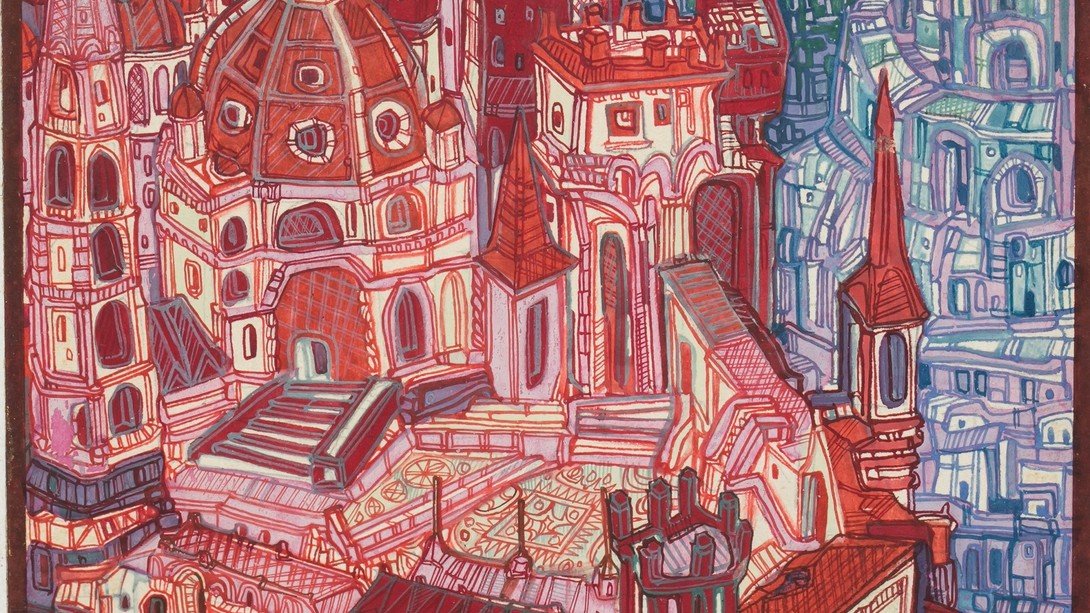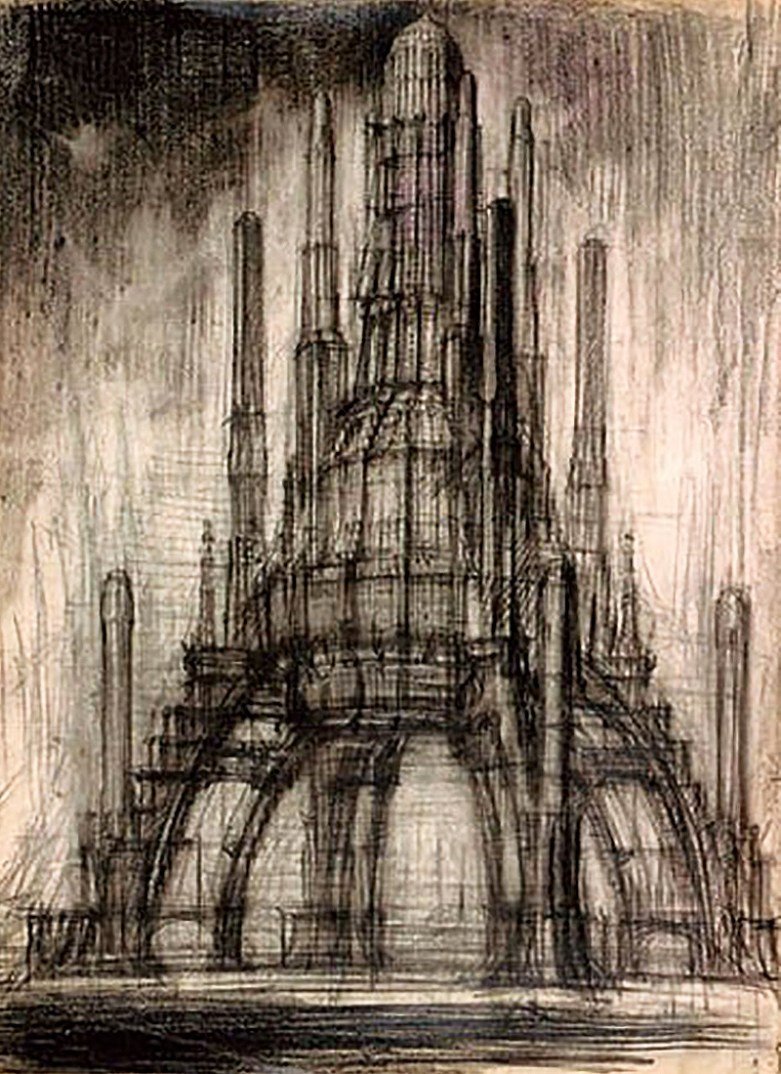The Mad Genius of Gothic Architecture
Editor’s Note: We received this manuscript in the mail as a manila envelope with no return address. The manuscript and accompanying blueprints were smeared in blood, bits of thread, and what appeared to be a crow feather. We decided to publish the piece in its entirety, with no edits, other than omitting several strange sentences which appear to be of Basque origin.
How close has man got to replicating the wonder of natural creation? The first thing that comes to mind is Gothic architecture. Why? When we stand humbled in its grand wide halls, under its ascending arches, we are reminded of the soaring trees of the forest. The grand pillars and vaults are the trunks and branches of high oaks, and on the exterior of these noble temples, the piercing stone fingers reach desperately towards the heavens.
Samuel Taylor Coleridge said, “The principle of Gothic architecture is infinity made imaginable.” This is the key to understanding Gothic style. Its principal source of aesthetics are the ever-expanding gigantic forests of northern Europe. This was derived from a much older, pre-Christian belief that the forests, the sacred grove, were places of the divine—and what is nature if not the expression of the divine? If Gothic architecture is man’s highest expression, can we not see it as a way for man to replicate divine creation? I not only say “yes,” I urge us to go further—to resurrect Gothic architecture in our time and let it grow, taller than the oaks of old Europe, taller than the snowcaps of the Himalayas, consuming Earth in its glory before, like a fungus, expelling itself into space and conquering the heavens in its image.
I get ahead of myself…what exactly is Gothic architecture? It was an architectural style used mainly for churches and cathedrals, centers of the faith. It was first developed between 1135 and 1144 with the construction of the Abbey of Saint-Denis near Paris. While architectural innovations like rib-vaults (criss-crossed arches) had existed in Europe for a century, the Abbey of Saint-Denis combined, for the first time, the classic Gothic features: rib-vaults, buttresses, pointed arches, and more. This birthed a new architectural style that emphasized verticality and the effect created by light beaming down through stained glass windows. Verticality and light express the core message of the Gothic style: the chance for man to participate in the divine, awash in light, before ascending to God.
Inside the Abbey of Saint-Denis.
Unfortunately the style was lamented by the Mediterraneans (blasted fools!). Gothic was seen as a “dark age” in architecture, the period between Greco-Roman Classical and the Revivalism of the Renaissance. Giorgio Vasari used the term “barbarous German style,” and I think that sums up the attitude by the era’s elites.
Over time, Gothic evolved into a more flamboyant and extravagant approach, reflecting the new wealth of the 12th century and beyond. High Gothic style was very forward and progressive: it multiplied the ribs of the vaults with new, purely decorative ribs called tiercons and liernes; it began using the “arc-en-accolade,” an arch over a window topped by a pinnacle; it moved from the more stoic and simple Romanesque style towards a more detailed, asymmetric, and chaotic nature. On any work of Gothic architecture, the pinnacles (pointy tops) will seem alive, multiplying in number and length and location. As Ralph Waldo Emerson said: “The Gothic cathedral is a blossoming in stone subdued by the insatiable demand of harmony in man.”
Crucial to Gothic architecture is the time which it takes to build these megaliths. In some cases, like the Notre Dame Cathedral, construction took over 300 years. The builders knew that they would perish before seeing the fruits of their creations; they hoped that the sons of their sons might; that their descendants would one day point to these glorious temples and declare, “Look! This is what our fathers built us. These were real men, and I am proud to carry their bloodline. Now, I shall finish what they started…”
The Possibilities of Gothic
Now that we understand the Gothic style, we will move towards its potential. We can go ridiculous with it. We can let megalomania overcome us. We can let unbridled ambition and the ravings of a madman take flight in our soul. And the main inspiration for this must be the work of Russian architect Yakov Chernikhov.
Chernikhov was a Soviet architect born December 1889 in Pavlograd, Ukraine, then part of the Russian Empire. He was one of many budding architects in the early Soviet Union; the rulers of this new nation wanted to rebuild their cities and many architects came running with bold, imaginative ideas. Emboldened by Idealism and Futurism, Yakov experimented with Constructivism and the Suprematism of Kazimir Malevich, a Russian avant-garde artist. Chernikhov, in his books, produced a number of richly designed architectural fantasies which could appropriately be called “Hyper-Gothic”: dominating, totalitarian, and triumphant in nature.
Chernikhov envisioned a grand metropolis of roaring Gothic megastructures—imposing concrete arches and stained glass depicting the saints and sagas of old—monuments depicting the empire’s many victories over its enemies and perhaps even its own people. These visions have been described as only “appropriate for the ‘Evil Empire,’ the colossal palaces [of Chernikhov] would dominate the city, squash the last vestiges of the soul, and yet strangely excite in their surreal dark presence.” This is the future I propose for us!
Unfortunately many of Chernikhov’s unique and strange designs caused the Soviet Union to distrust him. He could never realize his visions, most likely due to the fact that many considered him maniacal and the Stalinist regime was breathing down his neck. Many of his works were only published after his death.
Some see a man such as Chernikhov and fear him; they see a villain. I see a visionary. In our lifetimes, we can build upon his blueprints. We can join our dreams with his nightmares to build Gothic monuments that would make our ancestors fall to their knees and cry out for mercy. With the power of our minds, I want you to look at Chernikhov’s designs and imagine them ten times more epic and grand. Think a Gothic Dyson sphere circling a dying star, absorbing the entirety of its power, to feed a Gothic Matrioshka brain—a galactic supercomputer—so powerful it can literally modify the structure of the universe itself.
I myself have spent many a night furiously scribbling in my notebooks, completing Chernikhov’s designs. I have paid a terrible price for it. The possibilities of Gothic will drive a man mad…and yet it is my destiny to see them through. The wheels of the universe are spinning, and I have no choice but to endure my destiny. It is their destiny too. Even if they rip my heart out, they cannot stop what is already in motion.
Gothic architecture will rise again…
Follow Ingurdiz on Twitter.















